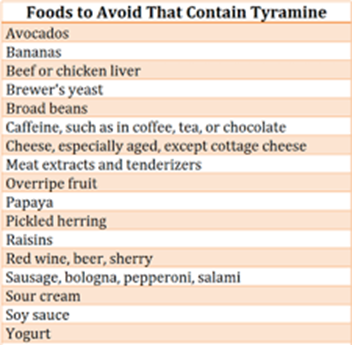A nurse teaching a patient about a tyramine-restricted diet would approve which meal?
Avocado salad, ham, creamed potatoes, asparagus, chocolate cake
Noodles with cheddar cheese sauce, smoked sausage, lettuce salad, yeast rolls
Mashed potatoes, ground beef patty, corn, green beans, apple
Macaroni and cheese, hot dogs, banana bread, caffeinated coffee
The Correct Answer is C
A. Contains foods high in tyramine like avocado, ham, and chocolate cake.
B. Includes smoked sausage and yeast rolls which are high in tyramine
C. This meal consists of foods typically low in tyramine content, suitable for a tyramine- restricted diet.
D. Macaroni and cheese, hot dogs, and banana bread can contain high levels of tyramine

Nursing Test Bank
Naxlex Comprehensive Predictor Exams
Related Questions
Correct Answer is C
Explanation
A. Providing medications against a patient's will generally requires a legal process or evaluation of capacity rather than a blanket statement of administration.
B. Clients who are involuntarily admitted might not have the right to refuse treatment initially based on the nature of the admission.
C. Involuntary admissions often allow for extended hospitalization based on the judgment of the treatment team.
D. Laws regarding restraints are generally consistent regardless of the mode of admission, focusing on safety and necessity rather than the mode of admission.
Correct Answer is ["B","C"]
Explanation
A. The term "subjectivity" might not be the most suitable word here and might not accurately represent cognitive-behavioral therapy's goals.
B. Cognitive-behavioral therapy involves exploring and challenging beliefs and perceptions about oneself, making this an appropriate response.
C. Homework assignments are often part of cognitive-behavioral therapy to practice skills or implement strategies outside of therapy sessions.
D. The statement is true regarding the therapist's active role but might not encompass the entire essence of cognitive-behavioral therapy.
Whether you are a student looking to ace your exams or a practicing nurse seeking to enhance your expertise , our nursing education contents will empower you with the confidence and competence to make a difference in the lives of patients and become a respected leader in the healthcare field.
Visit Naxlex, invest in your future and unlock endless possibilities with our unparalleled nursing education contents today
Report Wrong Answer on the Current Question
Do you disagree with the answer? If yes, what is your expected answer? Explain.
Kindly be descriptive with the issue you are facing.
